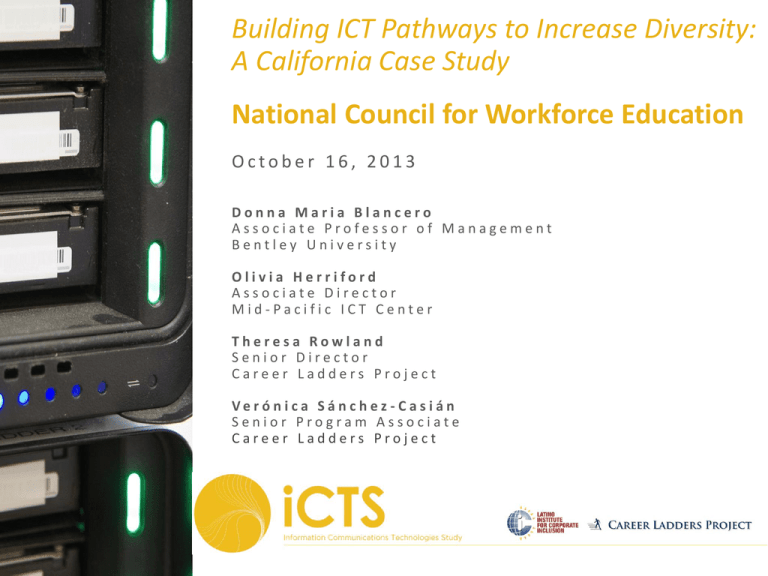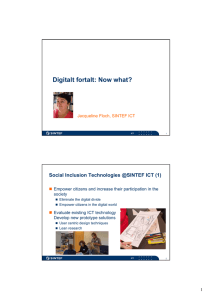Building ICT Pathways to Increase Diversity: A California Case Study
advertisement

Building ICT Pathways to Increase Diversity: A California Case Study National Council for Workforce Education October 16, 2013 Donna Maria Blancero Associate Professor of Management Bentley University Olivia Herriford Associate Director Mid-Pacific ICT Center Theresa Rowland Senior Director Career Ladders Project Ve r ó n i ca S á n c h ez - C as i án Senior Program Associate Career Ladders Project Tammy student story • Southern California high school graduate • African-American, from an under resourced urban school • It is 2010, mobile tech and social media jobs are booming • Tammy is interested in technology, but she is unsure of how to get there, no career training • High School preparation focused on point of graduation and little beyond that Sebastian student story • Northern California high school grad, no job or college plans • Latino, from a struggling Bay Area school district • Tech industry is booming; it’s 2010 • Hidden passion for technology and attracted to high wages • Sebastian’s school lacked resources for career exploration, without connection to role models What’s next for Tammy and Sebastian? student story What barriers keep young people from ICT careers? How do we increase African American and Latino participation in the growing ICT sector? What will it take to build a more diverse workforce for California’s future? overview Today’s Presentation • Project Partners • About the Study • Findings • Recommendations • Case Study: San Francisco ICT Pathways Project • Discussion/Q & A The Latino Institute for Corporate partnership Inclusion (L.I.C.I) “We exist to promote the role of Latinos in the future growth of Corporate American by establishing cooperative partnerships” LICI Founded in late 2007, the Latino Institute for Corporate Inclusion (“LICI”) works to assure the inclusion of Latinos in the “fabric” of Corporate America. – Research – Professional Development – Employment Career Ladders Project partnership • works in partnership with California Community Colleges and key stakeholders to provide educational and career advancement for Californians. • fosters opportunities through research, policy initiatives and strategic assistance to colleges and their workforce development partners. A Focus On about the study • California ICT Education and Workforce Development • Entry- and Mid-level ICT jobs • Lack of Diversity; building a case for change Methodology about the study Mixed Methods include: • Literature Review • Data Analysis of Educational and Labor Market Sources • In-depth interviews and a survey of employers, employees, educators and students in ICT and non-ICT industries in California • Peer review process with researchers, academicians, expert practitioners, and community stakeholders ICT Landscape in California findings California’s ICT Industries today account for: Almost $172 Billion or 6% of total California private sector revenues, ranking 6th among CA industries by revenue About 1 million workers or 1 in 17 California jobs Wages per ICT employee are more than twice the state average, second highest paying industry sector in California Between 2006 and 2016 the ICT industry employment is expected to grow by about 20% Source: California Community College Centers for Excellence, ICT Study Phase II 2010 ICT Industry and Employment Outlook. Data analysis conducted by Economic Modeling Specialists, Inc. (EMSI). literature rfindings eview f I n d in g s Current and Future California Workforce Labor Market and Demographic Projections: • Current Data (most recent available) • Projections for 2020 and 2025 • Educational attainment data projections Working Age (24-64) California Population by Race/Ethnicity Source: State of California, Department of Finance, January 2013 Population Entering and Exiting the California Workforce by Race/Ethnicity Source: State of California, Department of Finance, January 2013 2011 California Educational Attainment by Race/Ethnicity, Less than High School Source: U.S. Census Bureau, 2011 American Community Survey . 2011 California Educational Attainment by Race/Ethnicity, Age 25 or Older Source: U.S. Census Bureau, 2011 American Community Survey. Percent of California Adult Population with a Bachelor’s Degree or Higher by Race/Ethnicity: 2011 vs. 2025 Projections Source: U.S. Census Bureau, 2011 American Community Survey . Industry Voices on Education Demand findings “Most [ICT employees] have Bachelors of Science degrees in the field. Some have gone to trade school and made it through. Those with college degrees have the most potential to succeed… trade schools can provide opportunity to learn, but in major college they have a higher success rate. ….UC students show most deliverables, [they] are able to learn quicker, pick up on things other than what they learned in school.” Bank IT Regional Manager “We established a University Relations Department.” Recruitment Manager, Health Organization “When recruiting for an entry level position we look at a Senior in college. We are looking for leadership, degree match, GPA, experience in collaborative school projects, and involvement in volunteer work. Entry level for us requires a Bachelor’s.” Staffing Director, Communications Company findings California Community Colleges: a Prime Spot to Diversify ICT Education Community Colleges… • Most diverse student population • Serve the largest number of students of any public post-secondary system • Primary throughway to CSU and UC findings 2009-2010 ICT Degree Attainment by Race/Ethnicity as Percent of Total Degrees Awarded – Compared to Total California College-Going Age Population in 2010 Barriers to Entering ICT Jobs findings Limited information and opportunities about ICT professions and careers Limited opportunities for applied learning that opens doors to entry and middle-skill ICT careers and beyond Unclear steps and industry-required credentials along the pathway to ICT career entry and advancement Structural silos that isolate K-12 schools, community colleges, four-year institutions, workforce systems and industry Small scale of California’s inventive and effective career pathway programs and approaches Themes to Increase Latino and AfricanAmerican Participation in ICT recommendations Career Knowledge - Equip students with the information and support they need to make informed decisions about the pursuit of careers in ICT Experiential Learning - Prepare students for ICT careers and generate excitement for technology through applied learning in both educational and workplace settings at all levels of the educational continuum Collaboration - Leverage collective resources and synergize efforts to help students attain postsecondary credentials and advance in ICT careers through a ladder of opportunities recommendations Career Pathways: a Promising Strategy Build on a Career Pathways framework; focusing on a career ladder approach beyond entry-level jobs, including continuing education and certification to allow ongoing advancement Each step on a career pathway is designed explicitly to prepare the participant for the next level of employment and education When done well, pathways: recommendations • Include on-ramps or bridge programs for underprepared students with limited basic skills and youth and adults with barriers to employment • Span the entire range of programs from entry level, intensive “bridge” programs through occupational certificates and academic degrees • Are stackable in design, with certificates “nested” in longer transfer and degree structures, always preparing students for the next step • Contextualize basic skills and technical content to the knowledge and skills needed in a specific occupation or group of occupations When done well, pathways: recommendations • Provide an effective framework for workforce development by aligning with industry needs and integrating the resources • Focus on careers in demand that provide familysustaining wages and ongoing advancement opportunities as confirmed by industry partners • Include work based learning opportunities through structured experiences which could be credit-based and/or paid work experience, internships, or service learning • Use and promote data and focus on continuously improving outcomes Examples from the Field case studies Statewide: • Career Advancement Academies Regional: • San Francisco ICT Pathways Project Local: • CompTechs at DeAnza College and City College of San Francisco • California State University, East Bay • Pasadena City College Many more innovative efforts are happening! Mid-Pacific ICT Center case studies The Mid-Pacific ICT Center (MPICT) is an NSFfunded regional Advanced Technological Education Center. Its mission is to coordinate, promote and improve the quality of ICT education in California, Nevada, and Hawaii. In 2011, MPICT received a 4-year sub-award from the Broadening Advanced Technological Education Connections (BATEC) national center to pilot a collaborative project that defines, improves and promotes coherent and effective education and career pathways in ICT related fields. The project focus is on San Francisco pathways with the outcome being exportable, successful practices for use in other parts of MPICT’s region. sf ict pathways project Defining, Connecting, and Promoting ICT Education and Career Pathways in San Francisco Filling the Pipeline Two in three ICT-related firms and nearly half of non-ICT firms report some or great difficulty recruiting employees with appropriate ICT skills and training.* We must close this gap by growing our own ICT workforce. Now! *MPICT, Center of Excellence SF Bay Area (2013) Foundational Competency Employment Demand in California Project Focus Areas Education Pathways Working with education. Community-based organizations, and workforce development partners to define and strengthen pathways, identify barriers, and increase access to ICT education and preparation for careers through projects that link and expand programs, experiential learning, and faculty and student support. Awareness, Promotion Conducting outreach, developing collateral, and producing an online portal to provide information about ICT education and career opportunities to attract SF students into the pipeline that grows SF’s ICT workforce. Engaging the Ecosystem Working with the broader community of stakeholders to engage industry and employers to provide role models and experiential learning opportunities, best practices and professional development for K-14 ICT faculty, and better understanding of employer needs. A Collaborative Effort sf ict pathways project SF ICT Pathways Project Partners • TechSF (SF Office of Economic and Workforce Development) • WestEd • San Francisco Unified School District • City College of San Francisco • Bay Area Video Coalition • California Department of Education • BATEC • Career Ladders Project • sf.citi • Exploring Computer Science Role Models are Few: CCC ICT Faculty by Ethnicity Unknown, 431 Asian, 550 Black, 440 Hispanic/Lati no, 696 White, 3,846 Native American, 54 Pacific Islanders, 46 Two or more races, 34 MPICT (2012) California Community College ICT Student Enrollment and Demographics: A Study of Study of Enrollments and Demographics Related to Information and Communication Technologies (ICT) In California Community Colleges 2008/09 –2010/11 Tammy “I didn’t have teachers passionate…to help give you guidance about a career…So it was like, if you want to do something, just get out and do it with no help.” Tammy student story • She began taking community college classes • A digital pathways class introduced her to film production, design work, editing, and job readiness skills • She took workshops at The Bay Area Video Coalition and got connected to an internship at CouchSurfing • Through hard work and discovering her go-getter spirit, she now has a full-time job at CouchSurfing Sebastian student story • After high school, a local community center mentor introduced him to YearUp, a one-year ICT training program for urban youth • YearUp gave Sebastian technical and workplace etiquette skills, college credit, an educational stipend, and corporate internships • He became interested in college and is pursuing an AA degree in computer networking • He also works at Google on a team that supports Google Play, an app distribution service Sebastian To encourage more students of color to pursue an ICT career, Sebastian says: “Create awareness, have speakers that reflect the ethnicities and backgrounds of the kids they mentor, and create programs that show what the ICT field is all about.” discussion Q & A/Discussion • What are the implications of the study? How useful is the information? What will you do with these results? • How does this look in your state? Resources closing • MPICT Diversity Resources including a Toolkit, Link to the national Community of Practice, and more http://www.mpict.org/ict_educator_resources_improving_ict_diversi ty.html • MPICT ICT Demographic Study http://mpict.org/pdf/CCC_ICT_Enrollments_and_Demographics_1231-12.pdf • Diversity in California, an ICT Workforce and Education Study, to be released late Fall 2013 • www.latinoinclusion.org • www.CareerLaddersProject.org • Research Studies on the ICT Field for Community College Practitioners http://www.coeccc.net/ict/ closing Thank you! Donna Maria Blancero LICI D B l a n c e r o @ b e n t l e y. e d u Olivia Herriford MPICT OHerriford@mpict.org Theresa Rowland Career Ladders Project TRowland@CareerLaddersProject.org Ve ró n i c a S á n c h e z - C a s i á n Career Ladders Project VSanchez@CareerLaddersProject.org www.CareerLaddersProject.org









